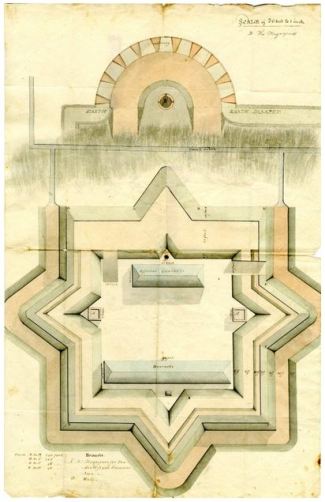by Jennifer Sharp for Your Public Media
Outraged by British restrictions on trade, the impressment of American sailors, and confrontations in the Northwest Territory, the United States declared war on Great Britain on June 18, 1812. That summer, as the war got underway, Secretary of War William Eustis wrote to Captain C. D. Wood in New London, Connecticut:
Sir, You will immediately commence the repairs of the magazine at Fort Trumbull and the block house at Fort Griswold and will forward estimates with your opinion of the enclosed plan & works for the harbour of new London.
Fort Trumbull, in New London, was in fact rebuilt in 1812. We do not know what Wood thought of the plan, nor if it was ultimately used. The fort that was built was torn down in 1839, replaced by the structure that still stands.

David Tracey letter to his Father, August 1814 – Connecticut Historical Society
The plan is on a single sheet of paper, approximately 11×17 inches. An image of the profile is on the reverse side. A scale in the upper right corner of the document shows a representation of 20 feet to one inch. Various letters, listed in the lower left corner, denote distances between points of land, a well, and magazines for powder and fixed ammunition. Structures visible are the officers’ quarters and barracks.
New London was not attacked by the British, perhaps in part because of the strength of its fortifications. In April 1814, British troops rowed up the Connecticut River and burned about 20 vessels in Essex. In August 1814, they attacked Stonington. After the first night of fighting, David Tracey Jr. wrote to his father from Fort Trumbull, where he had witnessed the attack. “I take a few moments after the alarm and fatigue of last night to inform you some of those events which I presume are with you much [exaggerated].” Tracy continues to explain that the enemy fleet was within four miles of Stonington by 8:00 in the evening. By 9:30 the fighting had begun, and from the parapet of the fort, Tracey could see and hear the firing guns. He describes the militia’s response and ends by noting, “no one killed—3 wounded on our side one English Barge is said to have been sunk and all her crew Drowned.”
The war ended four months later with the signing of the Treaty of Ghent.
Jennifer Sharp was the Connecticut Historical Society’s Project Archivist, working on a manuscript cataloging project funded by the National Historical Publications and Records Commission (NHPRC).
© Connecticut Public Broadcasting Network and Connecticut Historical Society. All rights reserved. This article originally appeared on Your Public Media.
Note: ConnecticutHistory.org does not edit content originally published on another platform and therefore does not update any instances of outdated content or language.








